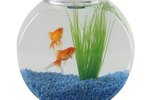
The ocean is one of the most stable habitats on Earth, particularly in regard to temperature. Captive saltwater fish need an environment that's just as stable -- tropical saltwater fish in particular. Otherwise, the stress caused by improper temperature will lead to disease.
Tropical
The majority of saltwater fish and inverts, or arthropods, you will see in a pet shop hail from the tropics. Tropical saltwater fish and inverts thrive in water that's 75 to 77 degrees Fahrenheit, about 24 to 25 degrees Celsius. Saltwater species can fare well in slightly cooler temperatures, as low as 72 Fahrenheit or 24.6 Celsius. However, the upper range of 77 degrees Fahrenheit is much harder for such species to adapt to. Additionally, hydrometers -- the best tool for measuring salinity, function best in this range.
Cold-Water Fish
Some cold-water species have begun to find their way into aquariums. The term "cold-water" is relative; species that live in the world's coldest regions rarely wind up in pet shops. Most cold-water species do their best at 50 to 60 degrees Fahrenheit, or 10 to 16 Celsius. These species can usually survive up to 72 degrees, but they thrive in the ideal range of 50 to 60 degrees.
Heating the Water
To control the temperature of your aquarium, you have several options. Tropical fish need a tank heater. Heaters come in different sizes, measured by wattage. Your fish tank needs about 5 watts of heater power per gallon of water. It's best to distribute this between two heaters in case one fails. This will buy you time to replace the damaged heater. A 10-gallon tank should have 50 watts of heater power. In this case, you would want to get two 25-watt heaters instead of one 50-watt heaters.
Cooling the Water
It takes more work to cool a fish tank than it does to heat it. For a cold-water aquarium, you will need a chiller. Chillers cost a lot of money because most are made with titanium heat exchangers, since cheaper materials like copper corrode when exposed to saltwater.
Good Practices
If you are keeping coldwater or tropical saltwater fish, follow standard practices: With any species you keep, you should always research them beforehand. Always make sure you have the right equipment before you get saltwater pets. Be sure you have enough heater power or an appropriate chiller. With all sea creatures, avoid sudden shifts in temperature. Never adjust the settings on your heater or chiller suddenly; this can cause stress.
References
- Majestic Aquariums: Questions on Temperature for Saltwater Aquariums
- FishChannel.com: Fish Tank Temperatures During the Summer; David Lass
- FishChannel.com: Sea Horses for Starters
- FishChannel.com: The Temperate Reef Tank - Part One; David Wrobel
- Aquarists Online: How to Calculate the Size of Aquarium Heater Needed; John Cunningham
Photo Credits
-
Jupiterimages/Photos.com/Getty Images


